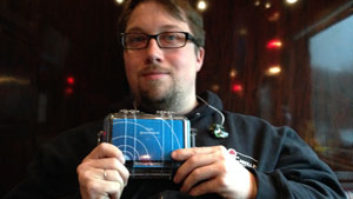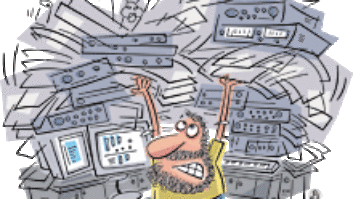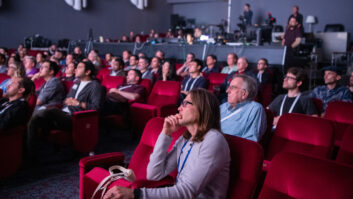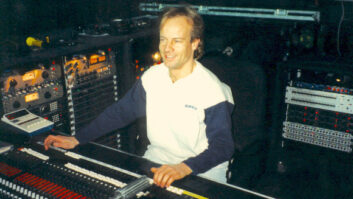A SOUND ENGINEER EXPLORES THE NEW WORLD OF DSP-BASED HEARING AIDSStill wondering where to invest those unspent per diems? Looking for a technology sector industry in its infancy that will grow for the rest of your life? I have two words for you: hearing aids. The big all-star benefit for the new millennium will not be Live-Aid, Farm-Aid or Net-Aid. It will be Hearing-Aid.
Baby boomers are getting old. They are going to outlast their ears. They are also accustomed to constant aural stimulation, and they are not going to suffer in silence. And the technology is ready. Hearing aids are rapidly becoming more socially acceptable and more affordable. But unless you are getting ready for retirement or know someone who benefits from a modern hearing aid, you are probably unaware of recent advances in hearing aid technology. I was too, until I helped my 85-year-old father-in-law get a hearing aid.
HEARING AIDS: THEN AND NOWThe human hearing mechanism has evolved to meet the needs of its owners. Until comparatively recently, most humans led lives that were nasty, brutish and short, and only a minority lived long enough to be bothered by the inevitable decline in their hearing. But thanks to modern health care, many of us will live long enough to be great-grandparents, and, thanks to a new generation of hearing aids, many of us will hear our great-grandchildren’s first words. Technologically advanced hearing aids offer the promise that we will be the first generation in human history whose perception of sounds does not necessarily have to degrade substantially as we grow older.
The key phrase here is “technologically advanced.” As medical science has progressed, so have the solutions to our ills become more sophisticated. The first hearing aids were crude – cupped hands, an animal horn held up to the ear, then the illogically named speaking trumpet. Finally, early 20th century electrical technology ushered in the beginnings of modern hearing aids. Early systems used carbon mics, vacuum tubes, and large, expensive, nonrechargeable batteries that would last only a day. The advent of the transistor and solid-state technology meant that users were freed from unwieldy tube amplifiers, and designs became light enough to fit behind the ear or to be integrated into eyeglasses. Battery life was also greatly extended and sound quality improved as mics and speakers moved out of the carboniferous era.
In the case of externally worn devices, the appearance of hearing aids has not much changed, perhaps creating the illusion that the evolution of hearing aids has stalled. It hasn’t. It’s gone digital.
Inside a modern digital hearing aid is a dedicated DSP platform that rivals in scope the FFT analyzers that I have been using to align sound systems for the past 16 years. DSP offers digital filters, adaptive equalization, feedback suppression, noise suppression, multiband compression and more – all of the same hip stuff as in-the-ear monitors, except lower power and no radio transmitters.
DSP allows a hearing aid to be customized to compensate exactly for its owner’s unique hearing problem. There are essentially two types of hearing mechanism problems. The first is mechanical damage in the middle ear, where the eardrum is coupled to the fluid-filled cochlea. These types of problems can, in some cases, be fixed surgically or with implants, but they are rarely solved with external hearing aids. The second type is inner ear damage, which is often a normal product of aging, or can be the result of a birth defect or excessive exposure to loud sounds. In fact, the most common cause of hearing loss is presbycusis, a type of age-related audiological decay characterized as the loss of inner-ear sensitivity. The effect is like slowly rolling in a hi-cut filter and lowering the fader, and it generally increases in severity after age 60. Another common cause of hearing loss is acoustical trauma, which, in our industry, is likely the result of mixing monitors for Black Sabbath. For my father-in-law, it was his role as a tank commander in World War II that caused his hearing loss.
OBIE GETS HIS EARSIvan (Obie) Oberdan has been hard of hearing for 56 of his 86 years. In our family, we referred to him primarily as “hard of heading” due to his obdurate resistance to addressing the problem. He had bought a hearing aid back in 1966, but it amplified the background noise too much, so it was of little benefit and was a constant annoyance. We pointed out that a lot had happened since 1966, including the invention of the wheel and DSPs. We felt that the new technology should be given a chance. Obie finally agreed to a hearing test, and I happily went along to observe.
The audiologist explained to us, in language suitable for four year olds, how she would take the measured frequency response of Obie’s ears and apply an inverse response into the internal DSP filters. I let her know that I was an audio professional familiar with the concept of equalization and that talking to me as if I was a three-year-old would be more appropriate.
She then measured Obie’s hearing sensitivity with octave-interval sine wave tones. Obie’s threshold of hearing in his right ear was beyond the edge of the chart, and his “good” ear was nearly there.
Throughout my career as an alignment specialist, I have lived by one constant principal: reproduce the original signal as closely as possible. A hearing aid’s role seemed to me to be analogous to the filter set used to tune a sound system. However, just as in optimizing a sound system, although equalization is a crucial step toward creating a natural listening experience, taken alone it is not the intelligibility solution we seek. As we age, we also lose the ability of the ear to respond to a wide dynamic range. Not only do we lose sensitivity, but the elasticity of the basilar membrane also decreases, limiting its range of excursion.
This loss of dynamic range is, in some ways, more damaging than the loss of sensitivity at certain frequencies, because it limits our ability to discriminate between useful signals and noise. We live in a world of background noise. We are able to converse because our binaural hearing system offers several complementary methods for screening out noise. Repetitive noises – such as HVAC systems and car noise or the sounds of whining children or nagging spouses – are unconsciously classified as information-free and are therefore ignored by our thought processes. Our binaural directionality allows us to localize an interesting sound source and focus on it, a trick that allows us to converse at a party while hundreds of voices nearby are transmitting in the same frequency range. This is known as the “cocktail party” phenomenon and actually requires a considerable amount of mental processing power. To get some idea of how mentally taxing this active listening can be, simply listen to a mono recording from a single mic placed in the middle of a room with several people conversing. For a person with compromised binaural directionality, the only way to sort out the important information is to concentrate on only the loudest signals.
With an undamaged human hearing system, which naturally has an extremely wide dynamic range (at least 120 dB), this discrimination is quite possible. But for someone with significant hearing loss – and a consequently diminished dynamic range – many of the conversations at a cocktail party will be heard at close to the same level, making for a poor signal-to-noise environment.
Fortunately, modern DSP technology provides the tools to deal with some of these problems. Equalization to compensate for lost sensitivity in the speech frequencies is fairly straightforward. Also, modern DSP-based hearing aids use as many as 14 frequency-conscious limiters, each controlling one band of audio so that overload in one range causes compression only in that range. This mimics the ear’s natural limiting system and allows speech to remain intelligible, despite the presence of noise.
For the repetitive noise problem, a DSP chip can scan the incoming sound for repetitive signals and filter out those sounds identified as noise. Binaural localization can be immensely improved by providing hearing aids for each ear, each tailored to that ear’s deficiencies. Another advance made possible with DSPs is the inclusion of speech recognition algorithms that can dynamically modify the vowels and consonants. For example, whereas we hear the word “stop,” the hearing impaired person with limited dynamic range hears “stOp” with the vowel sound “o” way above the consonants. The speech-enhancement system can restore the balance of vowel and consonants by expanding the consonants and compressing the vowels.
At present, there are two principal types of hearing aids. The “in-the-ear” types are tiny units that fit discretely into the ear canal. However, these are suitable only for moderate levels of hearing loss. Because the microphone (input) and speaker (output) are so close together, in-the-ear systems can offer only low gain before feedback.
The “behind-the-ear” models also feature a miniature loudspeaker embedded within a custom mold that fits in the ear canal, but placing the microphone behind the ear yields a much higher gain before feedback. This was the only option for Obie.
Additional features of current models include a rear facing cancellation microphone, which can be engaged in noisy environments. DSP also allows for automatic feedback suppression.
Research continues, and aging baby boomers can be counted on to swell the market for decades to come. As I look forward to my golden years, I take comfort in knowing that when I finally need a hearing aid, the state of the art will have advanced even further. If it all pans out as I hope, we will enjoy the power and fidelity of the audio industry’s in-ear monitors, along with the intelligibility processing developed by hearing aid research and development teams.
As for Obie, I can tell you that this has made all of the difference in the world. He is part of our world and part of our conversations. As we left the audiologist’s office on the first day of his new ears, we emerged into the parking lot as cars passed on the busy street. “What the heck is all that noise?” Obie asked. “That’s called traffic. Welcome to the real world,” I replied. Says Obie, “Now, if somebody can find a way to get rid of that, we would really have something.” Ain’t that the truth.
SOME HEARING F.A.Q.SNamed for its founder, Dr. Howard House, the House Ear Institute of Los Angeles is a private nonprofit scientific center dedicated to improving the quality of life for people who have hearing and related disorders through research and education. Sound Partners is the Institute’s hearing conservation program that focuses on hearing health issues in the music, pro audio and sound industries. To find out more, visit www.hei.org or call 213/483-4431.
How is hearing measured?
An audiogram is the graph measuring the lowest level that each ear hears a pure tone. Sound professionals should have their hearing checked annually in order to monitor any changes.
What frequencies are tested?
Most medical practices test each ear at 250 Hz, 500 Hz, 1 kHz, 2 kHz, 4 kHz, 6 kHz and 8 kHz (the speech range), because hearing loss in these frequencies affects one’s ability to communicate.
Why are the higher frequencies not tested?
Although hearing screenings at higher frequencies are available, accurate test results above 12 kHz are difficult to obtain, because no reference point for normal hearing thresholds is available. This is due in part to a lack of research to establish a standard method, equipment limitations and difficulty in reproducing testing conditions.
When does sound become hazardous?
The main factors contributing to a hazardous environment are high sound levels, the duration and frequency of exposure, and individual susceptibility.
What is nerve damage?
Nerve damage, or sensorineural hearing loss, occurs in the cochlea or hearing organ. It is permanent and incurable.
What are the hair cells referred to in hearing?
The outer hair cells are the sensory cells in the cochlea and are so named because of the hair-like projection at their tip. When damaged, these nerve cells do not regenerate and permanent hearing loss occurs – although scientists at the Institute are working on this.
What is Tinnitus?Tinnitus is a symptom, not a disease, and may be due to a number of ear- or hearing-related problems. It is a ringing, roaring or whooshing sound in the head that may be temporary or permanent in nature.
What causes Tinnitus, and is it treatable?
The simple answer is stress. Chemical stress can be caused by an excess of coffee, by aspirin or as a side effect of medication. Acoustic stress is caused by overexposure to loud sound. Physical stress is often the result of exertion or an illness. Pathological stress is due to a blockage in the auditory system (such as wax in the ear canal) and emotional stress. Tinnitus may be treated through a controlled diet, biofeedback and the use of electronic masking devices. It may be managed, but it cannot be cured.
Can regular exposure to high sound levels affect your health?
Yes. Prolonged exposure to loud sound tends to make your heart beat faster, resulting in an increased flow of blood throughout the body. On a recurring basis this may have a cumulative effect and may cause headaches, irritability, insomnia, hypertension, fatigue, reduced efficiency and ability to concentrate, and even low morale. Temporary threshold shifts or a muffled sound sensation may be experienced for a few hours or even days after sound exposure. Continued unprotected exposure to sound may lead to permanent threshold shifts or nerve deafness. Tinnitus is also a common disorder associated with overexposure to sound with the emitted signal increasing steadily over time.
Does flying affect one’s hearing ability?
Some people’s hearing ability may be affected by flying, because their Eustachian tubes are unable to efficiently equalize the pressure in the middle ear. The ear pain or discomfort experienced when the airplane descends may be alleviated by yawning, chewing gum or sucking a piece of candy. Special equalizing ear filters are also available. It is advisable to avoid flying when one has a head cold, an allergy attack or a sinus infection, as blocked nasal passages may increase the discomfort and even lead to a burst eardrum. If flying is unavoidable, use a decongestant to clear the nasal passages 24 hours before departure and a nasal spray 45 minutes before the aircraft is due to land.
Are there any foods or beverages that affect one’s hearing?
Caffeine, chocolate, alcohol and any form of stimulant have a diuretic effect that shrinks the vascular system. This may lower one’s hearing threshold and increase the volume of a Tinnitus signal. An allergy to certain foods may also cause hearing loss.
Are there any dietary supplements that promote hearing health?
Niacin, a vitamin B-complex, increases blood flow and may be used to counteract poor circulation. Gingko biloba is often promoted as having beneficial properties, but there is no scientific proof that it enhances hearing.
Do medications have an affect on hearing ability?
Yes. Aspirin and other salycilates act as stimulants and may increase hearing loss or Tinnitus. Anti-inflammatory agents, aminoglycosides such as neomycin, pain medications such as Vicodin, loop diuretics, steroids and quinine-based medications may also affect one’s hearing. It is important to ask your physician if the prescribed medication is ototoxic or reacts adversely with another medication.
Unlike sound equipment that can be repaired or replaced, you only get one set of ears. Once ears are damaged, you can’t tweak, fix or replace them. Yet, despite the fact that ears are among the most valuable tools that musicians and sound engineers possess, they are often neglected.
Prolonged and frequent exposure to loud sound is one of the leading causes of permanent hearing loss. Sound engineers and musicians are obviously at higher than normal risk for noise-induced hearing loss. And, unlike those in other noisy occupations, their livelihoods and careers may depend on their hearing.
The good news is that noise-induced hearing loss is totally preventable. The bad news is that many sound engineers and musicians are not motivated to protect their hearing until they notice a problem. They may become concerned only after experiencing constant ringing in the ears or getting comments that their mixes are overly bright and brittle-sounding. Though it’s never too late to commit to using hearing protection, the time to think about it – and act – is before problems arise.
MUSIC-INDUCED HEARING LOSSNoise- and music-induced hearing loss is a function of exposure time, the average noise level and the peak level of very loud sounds. Damage from excessive noise occurs, for the most part, in the cochlea – the tiny, snail-shaped structure located in your inner ear. A healthy cochlea is lined with thousands of minuscule hair cells, which, when stimulated, brush against nerve endings that send sound messages to the brain. Hair cells located along various portions of the cochlea correspond with different frequencies. The hair cells that line the outermost portion of the spiral respond to higher frequencies, and those in the innermost portion respond to lower frequencies. The hair cells that respond to high frequencies are especially vulnerable to excessive noise and are usually the first to be affected. Once the hair cells are damaged, sound transmission becomes impaired, and once the hair cells are gone, they’re gone – they don’t grow back and cannot be replaced.
Noise-induced hearing loss occurs gradually and insidiously. After a loud gig or rehearsal, you may experience reduced hearing acuity; sounds and voices may appear to be muffled or distant for a day or so. The muffled sensation may be accompanied by an annoying ringing in your ears (Tinnitus). With appropriate ear rest, the ringing will probably subside and your hearing will recover. This is referred to as a “temporary threshold shift.” But if this temporary threshold shift occurs night after night, week after week and year after year, the result may be “permanent threshold shift.” If you notice ringing in your ears or even a slight change in your hearing, pay attention – these are red flags that should not be ignored.
Individual susceptibility to noise-induced hearing loss varies, and it’s difficult to predict who will sustain permanent hearing loss and who won’t. As professional sound engineers and musicians, you must respect the fact that the nature of your work puts you at a high risk for excessive noise exposure. The following questions may help you determine whether you are at risk.
– Do you need to shout to be heard by others during studio work, rehearsals or performances?
– Have you ever noticed a ringing noise in your ears for hours or even a day after sound/music exposure?
– Does music sound distorted toward the end of a long rehearsal or recording session?
– Do voices sound muffled after you’ve been around music for a long period of time?
– Do your ears sometimes feel full or like they’re “shutting down” following a long day of recording or rehearsing?
– Does your home stereo system sound defective when you return home after a tour?
If your answer to any of these questions is yes, you are at risk for noise/music-related inner ear damage. If you haven’t done so already, have your hearing evaluated and embark on a hearing conservation program immediately.
HEARING TESTThe first step to protecting your ears is to find a good audiologist, preferably one who has experience with and knowledge of the unique needs of musicians and sound engineers. The audiologist will recommend that you have a baseline hearing evaluation. Although it’s not unusual for music industry personnel to resist this step, the information it provides is critical. Without a baseline, the audiologist has no way of monitoring the efficacy of the recommended plan of action. The only way to objectively determine whether your hearing protection efforts are working is to retest periodically and compare the results to the baseline audiogram.
Even if you opt not to have your hearing tested, don’t let it stop you from checking out your hearing protection options. Depending on the type of work you do, the amount of time you’re around loud music, the levels you’re exposed to and your budget, the audiologist can help you determine the most appropriate hearing protection device. Typically, the recommendation will be for custom musician earplugs (passive hearing protection), in-ear monitors (active hearing protection) or both.
CUSTOM EARPLUGSBy now, most seasoned musicians and sound engineers are aware of the custom earplugs designed by Etymotic Research (ER). For those of you who are new to the field, are unaware of the advantages of the ER plugs, or just haven’t gotten around to getting fitted yet, the following explanation of how they work will, hopefully, motivate you to try a pair.
Conventional over-the-counter ear- plugs present three basic problems: First, most generic earplugs produce 10 to 20 dB more attenuation in the high frequencies than in the mids and lows, making music and voices sound muffled and distorted. Second, traditional earplugs tend to create a large occlusion effect, making sound transmitted by bone conduction (e.g., the wearer’s voice) unnaturally loud and creating the perception of voice distortion and a plugged up feeling in the ears. Finally, conventional earplugs often provide more sound reduction than musicians and sound engineers can tolerate. Because of these problems, even the most ear-conscious musicians and engineers have abandoned efforts to wear them.
The Etymotic Research plugs are specifically designed for musicians; they allow you to protect your ears comfortably, without sacrificing fidelity. Fidelity is preserved by incorporating a small-diaphragm filter, similar to a passive speaker cone. The diaphragm, designed to follow the shape of the natural frequency response of the open ear (but at a reduced level), provides a nearly flat response, giving equal attenuation at all frequencies. The occlusion effect is reduced by the earplug’s design, which requires a deep seal in the second bend of the ear canal. Finally, the filters are available in reduction levels of either 15 dB, 25 dB and, more recently, nine dB.
The ER-15s are intended for use in environments where the A-weighted sound pressure level is 105 dB or less. The ER-25s are better for situations that exceed 105 dB. The ER-9 plugs were developed more recently to address requests from musicians who wanted a high-fidelity earplug with a little less attenuation than the ER-15. The ER-9 provides noticeably less attenuation in the low and mid frequencies. Because the frequency response is not flat, the fidelity isn’t quite that of the ER-15. The filters are all the same size and can be used interchangeably.
IN-EAR MONITORSMore and more performers and sound engineers are using in-ear monitor systems, which can (if used responsibly) reduce ear fatigue. With in-ear monitors, you can isolate your ears from ambient stage volume and virtually eliminate competitive monitoring. These high-fidelity, miniature speakers embedded in custom ear pieces enable you to hear the full dynamic range of your music without experiencing ear-shattering sound levels. If you use or are considering using in-ear monitors, ask your audiologist for guidance regarding safe use. Unlike the earplugs, which are a passive form of protection, in-ear monitors place an active sound source directly in your ears.
Thus, in-ear monitors, while they offer numerous advantages over conventional wedge monitors, should be viewed as hearing protection devices only if used with guidance regarding safe use. Safety can be best assured by obtaining an initial baseline hearing test, determining appropriate volume settings based on in-ear sound level measurements, using an earmold that provides a deep seal and good sound isolation, and rechecking your hearing periodically (at least once a year) to monitor any changes. Because in-ear monitoring is relatively new, many audiologists are unfamiliar with the technology and are ill-prepared to address questions on fitting and safety issues. If you need assistance in locating an audiologist who has experience in fitting in-ear monitors, contact Lisa Tannenbaum via e-mail at [email protected].
Hearing Education and Awareness for Rockers (H.E.A.R.) is a volunteer-based, nonprofit organization. Since its inception in 1988, H.E.A.R. has worked to educate the public on the dangers of excessive noise levels in music. Many audiologists, otolaryngologists, musicians, DJs, sound engineers and equipment manufacture champion H.E.A.R.’s cause. These “H.E.A.R. affiliates” are listed on H.E.A.R.’s award-winning Web site, which also offers information on hearing protection, custom earplugs, in-ear monitors and hearing aids. For more information on H.E.A.R. and a comprehensive set of links to hearing- and music-related Web sites, visit www.hearnet.com. H.E.A.R. also maintains a 24-hour hotline at 415/773-9590.






